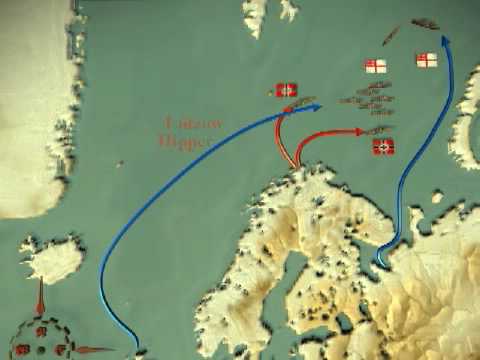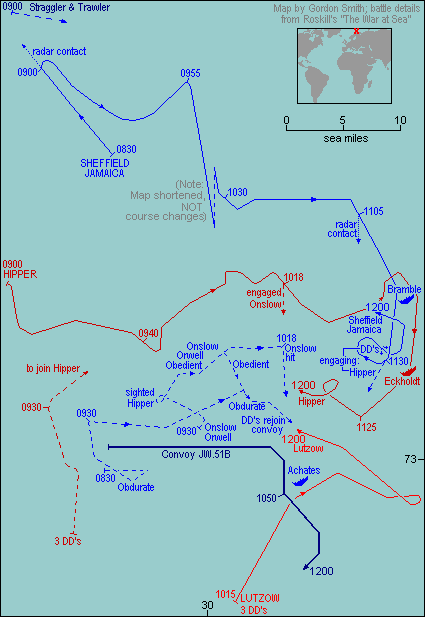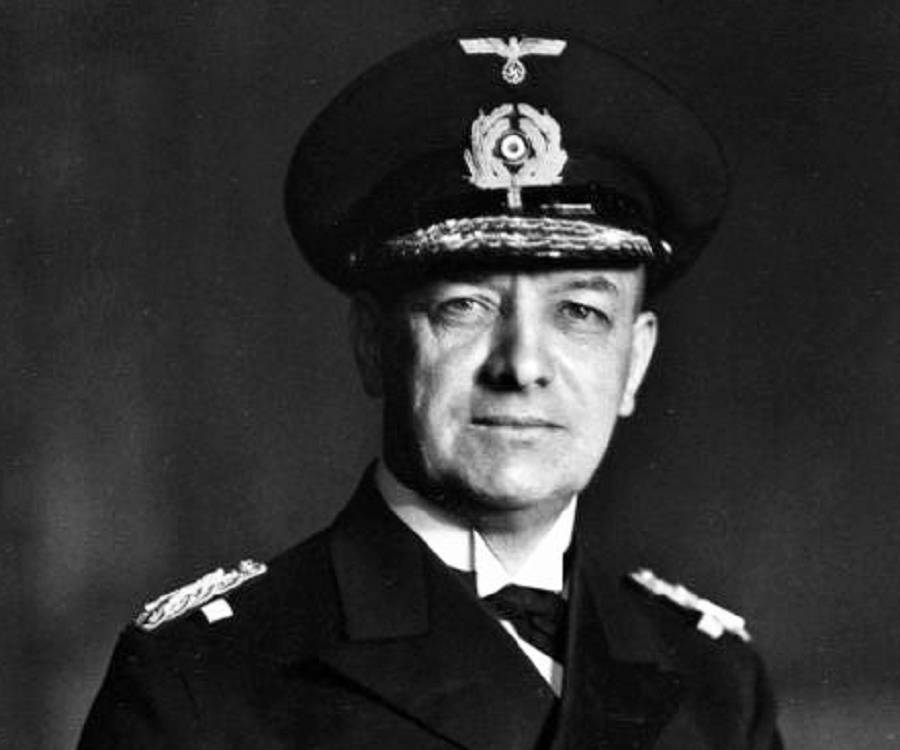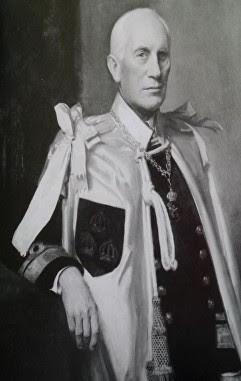
Fire in the Sky, the book by Michael Pearson that detailed the battle
The Battle of the Barents Sea was a World War II naval engagement on 31 December 1942 between warships of the German Navy (Kriegsmarine) and British ships escorting convoy JW 51B to Kola Inlet in the USSR. The action took place in the Barents Sea north of North Cape, Norway. The German raiders’ failure to inflict significant losses on the convoy infuriated Hitler, who ordered that German naval strategy would henceforth concentrate on the U-boat fleet rather than surface ships.
Convoy JW 51B
Convoy JW 51B comprised fourteen merchant ships carrying war materials to the USSR — some 202 tanks, 2,046 vehicles, 87 fighters, 33 bombers, 11,500 short tons (10,433 t; 10,268 long tons) of fuel, 12,650 short tons (11,476 t; 11,295 long tons) of aviation fuel and just over 54,000 short tons (48,988 t; 48,214 long tons) of other supplies. They were protected by the destroyers HMS Achates, HMS Orwell, HMS Oribi, HMS Onslow, HMS Obedient and HMS Obdurate; the Flower-class corvettes HMS Rhododendron and HMS Hyderabad; the minesweeper HMS Bramble; and trawlers Vizalma and Northern Gem. The escort commander was Captain Robert Sherbrooke RN (flag in Onslow). The convoy sailed in the dead of winter to preclude attacks by German aircraft, like those that devastated Convoy PQ 17 and inflicted heavy casaulties on Convoy PQ 18. Force R (Rear-Admiral Robert L. Burnett), with the cruisers HMS Sheffield and Jamaica and two destroyers, were independently stationed in the Barents Sea to provide distant cover.
Operation Regenbogen
On 31 December, a German force, based at Altafjord in northern Norway, under the command of Vice-Admiral Oskar Kummetz, on Admiral Hipper set sail in Unternehmen Regenbogen (Operation Rainbow). After Convoy PQ 18, the force had waited to attack the next Arctic convoy but their temporary suspension by the British during Operation Torch in the Mediterranean and Operation FB, the routing of single ships to Russia, had provided no opportunity to begin the operation. The force comprised the heavy cruisers Admiral Hipper, pocket battleship Lützow (the renamed Deutschland), and destroyers Friedrich Eckoldt, Richard Beitzen, Theodor Riedel, Z29, Z30 and Z31.
Prelude
JW 51B sailed from Loch Ewe on 22 December 1942 and met its escort off Iceland on 25 December. From there the ships sailed north-east, meeting heavy gales on 28–29 December that caused the ships of the convoy to lose station. When the weather moderated, five merchantmen and the escorts HMS Oribi and Vizalma were missing and HMS Bramble was detached to search for them. Three of the straggling merchantmen rejoined the following day; the other ships proceeded independently towards Kola Inlet. On 24 December the convoy was sighted by German reconnaissance aircraft and from 30 December was shadowed by U-354 (Kptlt. Karl-Heinz Herbschleb). When the report was received by the German Naval Staff, Kummetz was ordered to sail immediately to intercept the convoy. Kummetz split his force into two divisions, led by German heavy cruiser Admiral Hipper and pocket battleship Lützow, respectively. However Kummutz was under strict orders from Hitler and OKW not to risk his ships by exposing them to danger with a fight with heavy Royal Navy vessels.
Battle
At 08:00 on 31 December, the main body of JW 51B, twelve ships and eight warships, were some 120 nmi (140 mi; 220 km) north of the coast of Finnmark heading east. Detached from the convoy were the destroyer Oribi and one ship, which took no part in the action; 15 nmi (17 mi; 28 km) astern (north-east) of the convoy HMS Bramble was searching for them. North of the convoy, at 45 nmi (52 mi; 83 km) distance, was Vizalma and another ship, while Burnett’s cruisers were 15 nmi (17 mi; 28 km) southeast of them, and 30 nmi (35 mi; 56 km) from the convoy. To the east, 150 nmi (170 mi; 280 km) away, the home-bound convoy RA 51 was heading west. To the north of the convoy, Admiral Hipper and three destroyers were closing, while 50 nmi (58 mi; 93 km) away German pocket battleshipLützow and her three destroyers were closing from the south. At 08:00 German destroyer Friedrich Eckholdt sighted the convoy and reported it to German heavy cruiser Admiral Hipper.

At 08:20 on 31 December, HMS Obdurate, stationed south of the convoy, spotted three German destroyers to the rear (west) of the convoy. Then, HMS Onslow spotted Admiral Hipper, also to the rear of the convoy, and steered to intercept with HMS Orwell, HMS Obedient and HMS Obdurate, while HMS Achates was ordered to stay with the convoy and make smoke. After some firing, the British ships turned, apparently to make a torpedo attack. Heavily outgunned, Captain Sherbrooke knew that his torpedoes were his most formidable weapons; the attack was feigned as once the torpedoes had been launched their threat would be gone. The ruse worked: German heavy cruiser Admiral Hipper temporarily retired, since Admiral Kummetz had been ordered not to risk his ships. The German heavy cruiser Admiral Hipper returned to make a second attack, hitting HMS Onslow causing heavy damage and many casualties including 17 killed. Although HMS Onslow ultimately survived the action, Sherbrooke had been badly injured by a large steel splinter and command passed to HMS Obedient.

Admiral Hipper then pulled north of the convoy, stumbled across HMS Bramble, a Halcyon-class minesweeper, and there was an exchange of fire; Admiral Hipper returning fire with her much heavier guns causing a large explosion on HMS Bramble. The destroyer Friedrich Eckholdt was ordered to finish off HMS Bramble, which sank with all hands, while Admiral Hipper shifted aim to Royal Navy destroyers HMS Obedient and HMS Achates to the south. HMS Achates was badly damaged under German gunfire but continued to make smoke until eventually she sank; the trawler Northern Gem rescued many of the crew. The Germans reported sinking a destroyer but this was owing to the misidentification of the minesweeper HMS Bramble; they had not realised HMS Achates had been hit.
The shellfire attracted the attention of Force R with her two cruisers, which was still further north and approaching fast in a suprise entry to the batle. Royal Navy light cruisers HMS Sheffield and HMS Jamaica approached unseen and opened fire on Admiral Hipper at 11:35, hitting her with enough six-inch shells to damage (and cause minor flooding to) two of her boiler rooms, reducing her speed to 28 knots (52 km/h; 32 mph). Kummetz initially thought that the attack of the two cruisers was coming from another destroyer but upon realising his mistake, he ordered his ships to retreat to the west. In another case of mistaken identity, German destroyers Friedrich Eckholdt and Richard Beitzen mistook HMS Sheffield for Admiral Hipper; after attempting to form up with the British ships, they were engaged by severe gunfire from HMS Sheffield with German destroyer Friedrich Eckholdt breaking in two under six inch shells and sinking with all hands.

Sinking of Frederich Eckholdt
Meanwhile German pocket batleship Lutzow , after making a huge circle maneuver , approached from the east and fired ineffectively at the convoy, still hidden by smoke from the crippled HMS Achates. Heading north-west to join Admiral Hipper, Lützow also encountered with Royal Navy light cruisers HMS Sheffield and HMS Jamaica, which opened fire. Coincidentally, both sides decided to break off the action at the same time, each side fearing imminent torpedo attacks upon their heavy ships from the other’s remaining destroyers. This was shortly after noon. Burnett with Force R (light cruisers HMS Jamaica and HMS Sheffield) continued to shadow the German ships at a distance until it was evident that they were retiring to their base, while the ships of the convoy re-formed and continued towards Kola Inlet.

HMS Onslow damaged after the battle
Aftermath
Analysis
The encounter took place in the middle of the months-long polar night and both the German and British forces were scattered and unsure of the positions of the rest of their own forces, much less their opponent. The battle became a rather confused affair and sometimes it was not clear who was firing on whom or how many ships were engaged. Despite this German attack on convoy JW 51B, all 14 of its merchant ships reached their destinations in the USSR undamaged. Royal Navy escorts in the convoy lost one destroyer HMS Achates and one minesweeper HMS Bremble , and destroyer HMS Onslow was badly damaged. German Navy lost one large destroyer Frederich Eckholdt and heavy cruiser Hipper was severely damaged.
Hitler was infuriated at what he regarded as the uselessness of the surface raiders, seeing that the initial attack of the two heavy cruisers was held back by a few Royal Navy destroyers before arrival of the two light cruisers. There were serious consequences: this failure nearly made Hitler enforce a decision to scrap the surface fleet and order the German Navy to concentrate on U-boat warfare.

Grand Admiral Erich Raeder

On 1st January 1943 , Admiral Erich Raeder, supreme commander of the Kriegsmarine was called to Reich Chanellory in Berlin and in there he was subjugated a terrible humiliation under a constant barrage of curses and verbal abuses by Hitler who blamed German Navy with cowardist attitute in battle and never deserving the attention , privalage and resources other services like Army or Luftwaffe desperately cried for and them he made his final decision of scrapping German surface fleet , using its guns aboard ships as coastal artillery and sailors as ground troops. (what really angered Hitler had been the fact that he heard this news of failure in Barents Sea which had been under very favorable tactical circumstances for Germans from BBC and Reuters first which made initial declerations. The loss of face and image of failure and incompatence after defeat in El Alamein , Operation Torch in North Africa and Sixth German Army encircled and about to be destroyed at Stalingrad pocket , another military defeat like that had been too much for Hitler who vented all his anger against Raeder. Of course Hitler had forgotten his own orders to Admiral Kummetz not to expose his ships to risk before sailing away )
When he heard Hitler’s outburst and intentions , a horrified Admiral Raeder pointed out that even just there with a “fleet in being” German Navy was tying down significant enemy resources (Royal Navy Home Fleet in Scapa Flow) and by scrapping surface assets , Allies would score a great naval success without doing anything but Hitler insisted on his decision. Admiral Raeder then offered his resignation—which Hitler reluctantly accepted. Raeder was replaced by Admiral Karl Dönitz, the commander of the U-boat fleet. (later Hitler declared to Donitz that “from now on only U-Boats matter to me in naval warfare”)
Dönitz saved several pieces of German surface fleet from scrapping; though heavy cruiser Admiral Hipper and two (Emden and Leipzig) of the German light cruisers were laid up until late 1944, while repairs and rebuilding of the battleship Gneisenau (which was very severely damaged by a RAF raid in February 1942 off Texel) , half built aircraft carrier Graf Zeppellin were abandoned. Heavy cruiser Prinz Eugen and pocket battleships Lutzow and Admiral Scheer were pulled into Baltic Sea for inland sea naval operations at Baltic coast. After this misadventure , only two German battleships remained in active operational service in Atlantic : Tirpitz and Scharnhorst along with their destroyer escorts. Although German E-boats continued to operate off the coast of France, only one more big surface operation against a Russia bound Allied convoy was executed after the battle. This was the attempted raid on Convoy JW 55B in December 1943 (one year later) by the battleship Scharnhorst. The German battleship was sunk by an escorting Royal Navy task force in what later became known as the Battle of the North Cape.

Captain Robert Sherbrooke
On British side Captain Robert Sherbrooke was awarded the Victoria Cross. He acknowledged that it had really been awarded in honour of the whole crew of destroyer HMS Onslow. In the action he had been badly wounded and he lost the sight in his left eye. He returned to active duty and retired from the navy in the 1950s with the rank of rear-admiral

Captain Sherbrooke VC , lost his eye
At the memorial for minesweeper HMS Bramble which sank with all hands, Captain Harvey Crombie said of the crew
“They had braved difficulties and perils probably unparalleled in the annals of the British Navy, and calls upon their courage and endurance were constant, but they never failed. They would not have us think sadly at this time, but rather that we should praise God that they had remained steadfast to duty to the end.”
The battle was the subject of the book 73 North by Dudley Pope and the poem JW51B: A Convoy by Alan Ross, who served on HMS Onslow.
 I have the greatest respect for the small ships that fought like they were battleships. It takes a lot of courage to take on the big boys, and what a violent end to be shelled to pieces. And all this in the cold and dark North Atlantic. I read there were no cheers among the british when Scharnhorst went down a year later, because they were all just sailors doing there job.
I have the greatest respect for the small ships that fought like they were battleships. It takes a lot of courage to take on the big boys, and what a violent end to be shelled to pieces. And all this in the cold and dark North Atlantic. I read there were no cheers among the british when Scharnhorst went down a year later, because they were all just sailors doing there job.